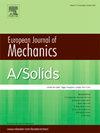基于深度学习的二维局部共振超材料低频带隙预测和弹性波传播特性
IF 4.2
2区 工程技术
Q1 MECHANICS
引用次数: 0
摘要
在声子晶体的减振降噪应用中,带隙的灵活设计是一个挑战。本研究基于新型二维局域共振(LR)超材料,创新性地构建了材料的空间分布与带隙特性之间的相关性,揭示了微观结构参数协同作用下的带隙形成机制。开发了一种将有限元法(FEM)与人工神经网络(ann)相结合的智能设计框架,通过参数化建模技术实现了海量数据集的快速生成,显著缩短了传统的试错设计周期,并对比验证了不同网络架构对带隙预测精度的增强效果。进一步发现,周期性阵列结构尺寸与单/双轴压缩应变可协同调节带隙范围,验证了周期性阵列结构尺寸优化与动态压缩控制相结合可有效扩大低频振动抑制带宽,可作为实现带隙主动设计的策略。这种可预测的带隙设计范式突破了传统试错法的局限性,为开发具有自适应调节能力的减振降噪超材料提供了新的理论框架和技术路径,在智能隔振设备和精密仪器保护领域显示出重要的应用价值。本文章由计算机程序翻译,如有差异,请以英文原文为准。
Deep-learning-based low-frequency bandgap prediction and elastic wave propagation properties of two-dimensional locally resonant metamaterials
Flexible design of bandgaps is a challenge in phononic crystals for vibration damping and noise reduction applications. In this study, based on novel 2D localized resonance (LR) metamaterials, the correlation between the spatial distribution of the materials and the bandgap properties is innovatively constructed, and the bandgap formation mechanism under the synergistic effect of microstructural parameters is revealed. An intelligent design framework integrating finite element method (FEM) and artificial neural networks (ANNs) is developed, which realizes the rapid generation of massive data sets through parametric modeling techniques, significantly shortens the traditional trial-and-error design cycle, and comparatively verifies the enhancement effect of different network architectures on the bandgap prediction accuracy. It is further found that the bandgap range can be synergistically regulated by the periodic array structure size and uni/biaxial compressive strain, which verifies that the low-frequency vibration suppression bandwidth can be effectively expanded by the combination of periodic array structure size optimization and dynamic compression control, and can be used as a strategy to realize the active design of the bandgap. This predictable bandgap design paradigm breaks through the limitations of the traditional trial-and-error method, and provides a new theoretical framework and technical path for the development of vibration- and noise-reducing metamaterials with adaptive adjustment capability, which shows important application value in the fields of intelligent vibration isolation equipment and precision instrument protection.
求助全文
通过发布文献求助,成功后即可免费获取论文全文。
去求助
来源期刊
CiteScore
7.00
自引率
7.30%
发文量
275
审稿时长
48 days
期刊介绍:
The European Journal of Mechanics endash; A/Solids continues to publish articles in English in all areas of Solid Mechanics from the physical and mathematical basis to materials engineering, technological applications and methods of modern computational mechanics, both pure and applied research.

 求助内容:
求助内容: 应助结果提醒方式:
应助结果提醒方式:


